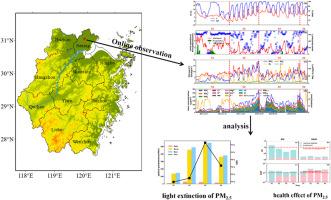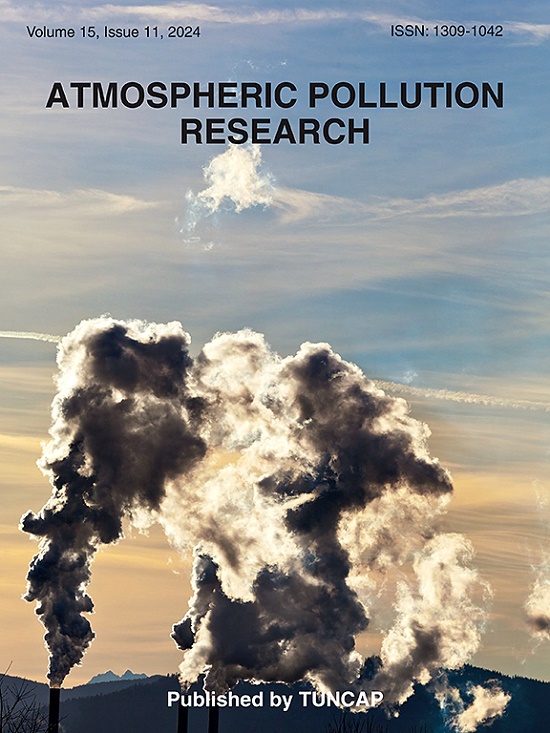Online observation of PM2.5 during a persistent haze in the Yangtze River Delta: chemical components, health effect and light extinction
IF 3.5
3区 环境科学与生态学
Q2 ENVIRONMENTAL SCIENCES
引用次数: 0
Abstract
Haze impacts visibility and health. To understand the effects of haze chemical components on health risks and atmospheric optics, PM2.5 chemical components during a haze event in Jiaxing (Dec 15, 2023–Jan 8, 2024) were analyzed. NO3− was the main component of water-soluble ions (WSIs) (45.07 %–58.20 %). Primary organic carbon (POC) was the main component of total carbon (TC) (55.12 %–78.21 %). In the clean and developing stages, Fe was the main component of metal. K was the main component in the maintenance and dissipating stages. In the developing stage, NO3− and secondary organic carbon (SOC) concentrations increased sharply, 3.86 and 18.75 times that of the previous stage. Among them, the increase of NO3− played an essential role in light extinction. In the maintenance stage, SO42− played a more critical role. Its contribution to PM2.5 was 1.68 times that of the previous stage, and the contribution of sulfate (Sul) to light extinction was 1.98 times that of the previous stage. The decrease in NO3− concentration mainly caused haze dissipating, but the contribution of Nitrate (Nit) to light extinction increased (62.30 %). From clean to maintenance stage, the contribution of WSIs to PM2.5 increased, while that of TC decreased. At the same time, the enrichment factors (EF) of heavy metals such as Fe, Ca, and Zn, as well as the non-carcinogenic and carcinogenic risk for kids, decreased but increased in the dissipating stage. The non-carcinogenic and carcinogenic risk for adults increased in the developing stage. Kids were more sensitive to PM2.5 than adults.

长三角持续雾霾期间PM2.5的在线观测:化学成分、健康效应和消光
雾霾影响能见度和健康。为了了解雾霾化学成分对健康风险和大气光学的影响,我们分析了嘉兴一次雾霾事件(2023年12月15日至2024年1月8日)期间PM2.5的化学成分。NO3−是水溶性离子(wsi)的主要成分(45.07% ~ 58.20%)。原生有机碳(POC)是总碳(TC)的主要组成部分(55.12% ~ 78.21%)。在清洁和发育阶段,铁是金属的主要成分。K是维持和耗散阶段的主要成分。在发育阶段,NO3−和二级有机碳(SOC)浓度急剧上升,分别是前一阶段的3.86和18.75倍。其中,NO3−的增加对光灭起着至关重要的作用。在维护阶段,SO42−起着更为关键的作用。其对PM2.5的贡献是前一阶段的1.68倍,硫酸盐(Sul)对消光的贡献是前一阶段的1.98倍。NO3−浓度的降低主要引起雾霾消散,但硝态氮(Nit)对消光的贡献增加(62.30%)。从清洁阶段到维护阶段,wsi对PM2.5的贡献增大,TC的贡献减小。同时,Fe、Ca、Zn等重金属的富集因子(EF)以及儿童的非致癌性和致癌性风险在消散阶段呈下降趋势,但在消散阶段呈上升趋势。成人的非致癌性和致癌性风险在发育阶段增加。儿童对PM2.5的敏感度高于成年人。
本文章由计算机程序翻译,如有差异,请以英文原文为准。
求助全文
约1分钟内获得全文
求助全文
来源期刊

Atmospheric Pollution Research
ENVIRONMENTAL SCIENCES-
CiteScore
8.30
自引率
6.70%
发文量
256
审稿时长
36 days
期刊介绍:
Atmospheric Pollution Research (APR) is an international journal designed for the publication of articles on air pollution. Papers should present novel experimental results, theory and modeling of air pollution on local, regional, or global scales. Areas covered are research on inorganic, organic, and persistent organic air pollutants, air quality monitoring, air quality management, atmospheric dispersion and transport, air-surface (soil, water, and vegetation) exchange of pollutants, dry and wet deposition, indoor air quality, exposure assessment, health effects, satellite measurements, natural emissions, atmospheric chemistry, greenhouse gases, and effects on climate change.
 求助内容:
求助内容: 应助结果提醒方式:
应助结果提醒方式:


